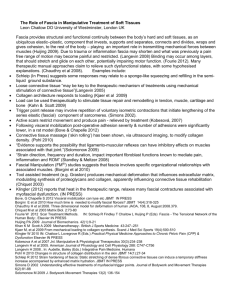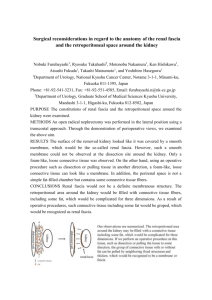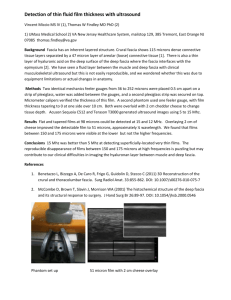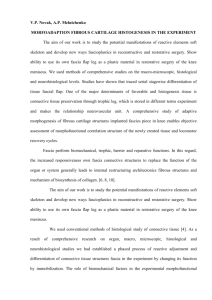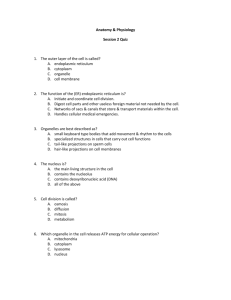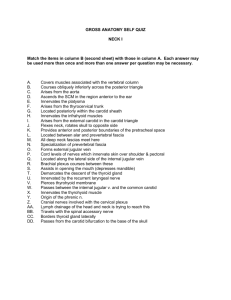Fascia - The Rolfing Center
advertisement
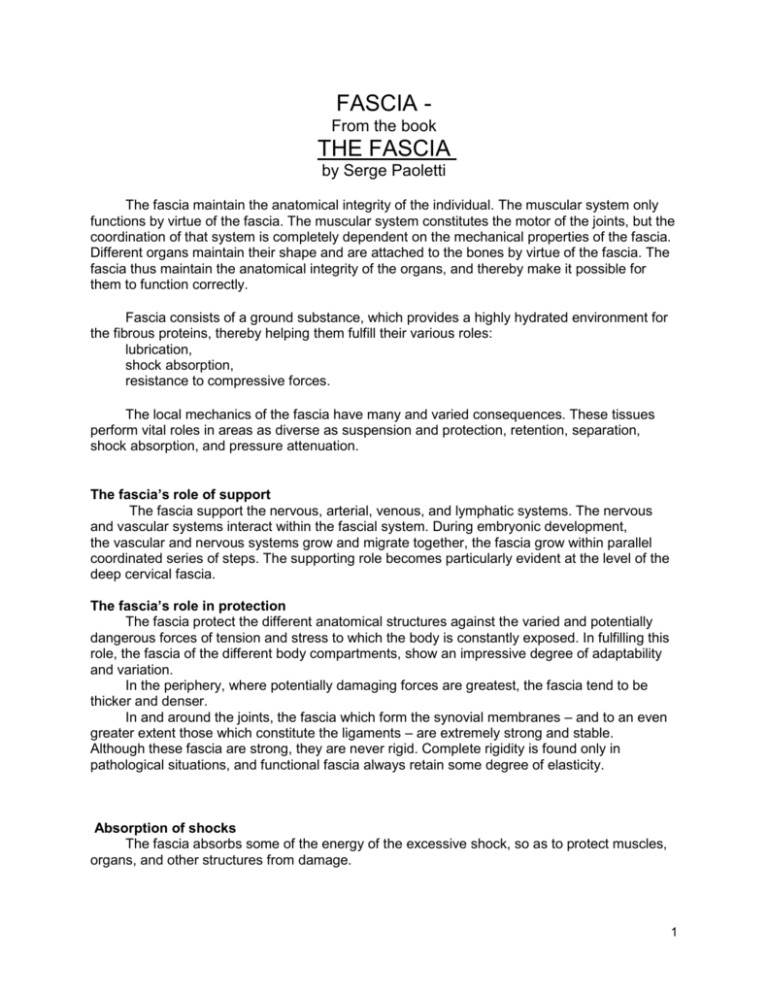
FASCIA From the book THE FASCIA by Serge Paoletti The fascia maintain the anatomical integrity of the individual. The muscular system only functions by virtue of the fascia. The muscular system constitutes the motor of the joints, but the coordination of that system is completely dependent on the mechanical properties of the fascia. Different organs maintain their shape and are attached to the bones by virtue of the fascia. The fascia thus maintain the anatomical integrity of the organs, and thereby make it possible for them to function correctly. Fascia consists of a ground substance, which provides a highly hydrated environment for the fibrous proteins, thereby helping them fulfill their various roles: lubrication, shock absorption, resistance to compressive forces. The local mechanics of the fascia have many and varied consequences. These tissues perform vital roles in areas as diverse as suspension and protection, retention, separation, shock absorption, and pressure attenuation. The fascia’s role of support The fascia support the nervous, arterial, venous, and lymphatic systems. The nervous and vascular systems interact within the fascial system. During embryonic development, the vascular and nervous systems grow and migrate together, the fascia grow within parallel coordinated series of steps. The supporting role becomes particularly evident at the level of the deep cervical fascia. The fascia’s role in protection The fascia protect the different anatomical structures against the varied and potentially dangerous forces of tension and stress to which the body is constantly exposed. In fulfilling this role, the fascia of the different body compartments, show an impressive degree of adaptability and variation. In the periphery, where potentially damaging forces are greatest, the fascia tend to be thicker and denser. In and around the joints, the fascia which form the synovial membranes – and to an even greater extent those which constitute the ligaments – are extremely strong and stable. Although these fascia are strong, they are never rigid. Complete rigidity is found only in pathological situations, and functional fascia always retain some degree of elasticity. Absorption of shocks The fascia absorbs some of the energy of the excessive shock, so as to protect muscles, organs, and other structures from damage. 1 When the body is subject to any kind of violent trauma at the surface, a shock wave is generated which propagates towards the interior. Such shock waves can conduct and deliver huge amounts of energy to the deep tissues, thereby causing serious damage to many different internal structures and organs, if the intensity of the original shock is strong enough. The role of connective tissue is to absorb that shock wave and to dissipate it in different directions so as to attenuate it and protect the physical integrity of the body. In certain situations, the energy cannot be fully absorbed and dissipated. Either the shock was too violent, or it struck an area which was already subject to abnormal tension. What can occur in this case is the formation of what Elmer Green has called ‘an energy cyst.’ That is, the concentration of a significant amount of energy within the connective tissue. Energy that sooner or later will have deleterious effects. Such a cyst of energy manifest by obstructing the normal conduction of electricity through the tissues of the body. It acts like an irritant, which can contribute to the development of an area, which is a propitious focus for the kind of phenomena conventionally associated with irritation. This leads to an increase in entropy and loss of function in the surrounding tissues. Protective role The fascia is also key in the vascular and nervous systems, that the fascia not only support, but also protect from compression, stretching, and other insults. Fascia and the hemodynamic processes. The vascular and lymphatic systems cannot be disassociated from the fascial system. The different orientations of the fascial fibers mean that the overall configuration of the fascia corresponds to a spiral arrangement. Hence when they contract, they have a tendency to compress the structures they are investing, thereby pushing the fluids back towards the heart, just like a dish cloth that is wrung out. If the fascia is in a state of abnormal tension, it is easy to understand that the associated vascular system would be subject to sustained pressure, which will induce stasis. Fascia and the maintenance of posture With respect to the role of fascia in posture, certain fascia are more active than others. The gluteal, cervical, and lumbosacral, and the ilio-tibial tract. The harder a fascial element has to work, the more it will consolidate its collagen network. This is why the fascia are the first structures to react to injury. As a general rule, it is the external fascia that are evolved in maintaining posture, which the internal fascia tend to be more important in support function. Fascia - 3 types 1. Subcutaneous - directly under the skin 2. Investing - line and surround individual skeletal muscles, bones, and their vessels and nerves 3. Visceral - envelop the gut, other organs, and body contents and their vessels, nerves and ducts 2 The bony tissue - Bony tissue can be thought of as fascia which has undergone thorough consolidation. Therefore, bone, like other types of fascia, is characterized by three key properties: elasticity, plasticity, and strength. There are two different modes of ossification for bones. First is endoconnective (membrane) ossification. This refers to the formation of bone from connective tissue. The bones that form from this are the bones of the calvaria, the facial bones, and the clavicle. The second type of cartilaginous ossification is a process pre - existing cartilaginous structures are replaced by bony tissue. Excerpts from a Paper presented at the Fascia Conference 2009 in Amsterdam. The Architecture of the Connective Tissue in the Musculoskeletal System – An often overlooked Functional Parameter as to Proprioception in the Locomotor System. Jaap van der Wal MD PhD University Maastricht, Faculty of Health, Medicine and Life Sciences, Department of Anatomy and Embryology, P.O. Box 616, 6200 MD Maastricht, The Netherlands. (BELOW, BOLD IS MY EMPHASIS - THOMAS) Schleip mentions the fascia “as the dense irregular connective tissue that surrounds and connects every muscle, even the tiniest myofibril, and every single organ of the body forming continuity throughout the body” (Schleip, 2003) In principle the primary connective tissue of the body is the embryonic mesoderm. This in fact represents the matrix and environment within which the organs and structures of the body have been differentiated and therefore are embedded. He stated the mesoderm as a so-called ‘inner tissue’ in opposition to the ectoderm and endoderm as ‘limiting tissues’. In histology, ‘limiting tissue’ is commonly called epithelium and is almost solely constituted by cells with relatively little intercellular space. Most derivatives of the so-called ‘inner tissue’ are identified in histology as connective tissue. ‘Inner tissue’ could therefore be described as undifferentiated connective tissue, in principle organized in three components: cells, intercellular space (interstitial substances) and fibers (Blechschmidt, 2004). This ‘inner tissue’ as connective tissue matrix exhibits two principles of ‘connection’. As to development and differentiation of the mesenchyme, one could describe functionally two principles or patterns. 3 1) There is the building out of the component ‘intercellular space’ which for example happens in the formation of coelom or body cavities and joint ‘cavities’, where spatial separation is ensured and therefore motion is enabled. This is the functional tendency and differentiation of 'creating space'. 2) There is the tendency of differentiation to a strict connection or connective tendency, i.e. the formation of a binding medium, either fibers (as in regular dense connective tissue structures like membranes and ligaments) or interstitial substrate and matrix (for example configured in cartilaginous joints). In phenomenological terminology however, it may be stated that the primary connective tissue can 'connect' (‘bind’) or it can 'dis-connect' (‘create room’). Here it will be discussed that intermuscular spaces might also exhibit two ways or degrees of connectivity. On the one hand it may appear as a kind of ‘mobile joint’ in the form of sliding and slipping spaces with loose areolar, bursa-like connective tissue as ‘dis-connecting’ medium. On the other hand there exist mechanical intermuscular septa constituted by regular dense connective tissue, appearing as tough connecting membranes offering an insertion area to the neighboring muscle fascicles (vide infra) NOTE: (based on the preceding paragraphs): The primal gestures of the embryo via the fascia are to Connect Create space. This is what we are doing in our work. Helping the being (body) to fulfill its primal gestures of space (extension) and connection. Ligaments can only perform their force conveying (stress transmitting) function in a very particular position of the joint (or: of the articulating bones) i.e. when they are stretched and loaded in a certain joint position (‘passively’). On the other hand, muscles are capable of this function in varying positions of the joint because they are able of a continuous adaption in length (‘actively’). 4 QUOTES “The soul of man with all the streams of pure living water seems to dwell in the fascia of the body. Thus a knowledge of the universal extent of the fascia is almost imperative and is one of the greatest aids to person who seeks cause disease.” Dr Still “Many of the changes that take place within the body exists as functional pathologies for considerable periods time before they are recognized as factual. Many of these changes are concerned with alteration of body fluids so intimately related to the connective tissue. Each normalization of the connective tissue should be attempted and the condition of the connective tissue determined if the best results are to be obtained.” Dr. Fluffed, DO “The fascia is the place to look for the causes disease and the place to consult and begin the action of remedies. By its action we live, by its failure we die.” Dr Still “Sickness is in effect caused by the stoppage of some supply of fluid or quality of life.” Dr. still 5

